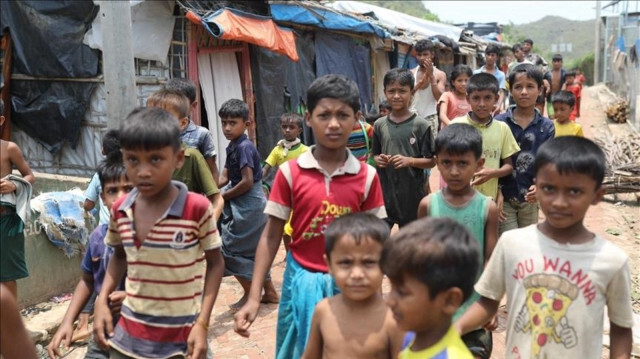
Rights groups have criticized UN for inaction and Bangladesh government for aid cutbacks
Six years after being uprooted from Myanmar through a campaign of targeted violence by the military junta, more than 700,000 Rohingya Muslims fled to neighboring Bangladesh, joining thousands of others who had fled earlier episodes of violence.
More than a million of them live in Bangladesh’s Cox Bazar alone, making it the largest refugee settlement in the world.
Many took to the sea to reach Malaysia, Indonesia, India and Thailand to escape from persecution. Their future looks as uncertain as ever.
Here is a timeline of one of the biggest contemporary refugee crises:
1977 - Then known as Burma, Myanmar launches Operation Dragon King (Naga Min) in Rakhine state. The Rohingya ethnic minority is declared "illegal" after being stripped of their citizenship, thus beginning a cycle of forced displacement.
1977-78 - Operation Dragon King includes mass arrests, persecution, and horrific violence, driving some 200,000 Rohingya across the border to Bangladesh, which opens refugee camps, where living conditions inside the camps are woefully inadequate.
By 1979, most of the Rohingya are repatriated to Burma. Of those remaining in Bangladesh, some 10,000 people die, the majority children, after food rations are cut.
1989 - Burma is renamed Myanmar after a military crackdown that followed the suppression of a popular uprising.
The ruling State Law and Order Restoration Council increases its military presence in northern Rakhine state, and the Rohingya are reportedly subject to compulsory labor, forced relocation, rape, summary executions, and torture. Some 250,000 Rohingya flee to Bangladesh.
1992 - The camps are closed to new arrivals in the spring and repatriation of Rohingya refugees to Myanmar begins in the fall, despite protests by the international community.
Over the following years, hundreds of thousands of Rohingya are sent back to Myanmar, and new refugees attempting the journey were denied entry to Bangladesh.
2003 - Of the 20 camps built in Bangladesh in the early '90s, two remain: Nayapara camp near Teknaf (above) and Kutupalong camp near Ukhia.
Living conditions remain dire—a study finds that 58% of children and 53% of adults are chronically malnourished.
2017 - On Aug. 25, 2017, a shadowy Rohingya armed group, called the Arakan Rohingya Salvation Army (ARSA), attacks police posts in Rakhine state, killing at least a dozen officers.
The army says it killed 400 armed fighters in retaliation, but critics said most of the dead were civilians.
The violence leads to the biggest-ever cycle of mass displacement.
MSF documents more than 6,700 violent deaths among the Rohingya.
Many world leaders allege ethnic cleansing.
2017 - Bangladesh and Myanmar on Nov. 23 agree to start repatriating refugees but the UN High Commissioner for Refugees says conditions are not in place for their safe return and the process halts.
UN human rights chief Zeid Ra’ad al-Hussein on Dec. 5 warns of possible “elements of genocide” and calls for an international investigation.
2018 - On Aug. 25, thousands of Rohingya refugees stage protests to mark the first anniversary of their exodus.
UN investigators call for the prosecution of Myanmar’s army chief and five other top military commanders for genocide, crimes against humanity, and war crimes.
An attempt to repatriate 2,260 Rohingya fails as they refuse to leave without guarantees for their safety.
2019 - On July 16, the US announces sanctions against Myanmar’s army chief and three other top officers. About 3,500 Rohingya refugees are cleared to return home but no one turns up to make the journey on Aug. 22.
On Nov. 11, Gambia files a lawsuit at the International Court of Justice (ICJ) accusing Myanmar of genocide.
Three days later, the Hague-based International Criminal Court (ICC) approves a full investigation into the persecution of the Rohingya.
In the same week, a third case is filed by rights groups in Argentina under the principle of universal jurisdiction.
On Dec.11, Aung San Suu Kyi leads Myanmar’s defense at the ICJ, and refutes accusations of genocide.
She admits the army may have used excessive force.
2020 - The ICJ on Jan. 23 orders Myanmar to take urgent steps to prevent alleged genocide and to report back within four months.
2021 - Myanmar military seizes power on Feb. 1 and puts Suu Kyi under house arrest and later sentences her to 17 years in prison.
2022 - The US on March 21, 2022, officially declared the 2017 violence amounted to genocide, saying there was clear evidence of an attempt to “destroy” the Rohingya.
On July 22, the ICJ rules that the case filed by Gambia can proceed.
Uncertainty persists that the Rohingya are especially vulnerable as stateless people, long denied citizenship in Myanmar.
With no official refugee status in Bangladesh, the Rohingya have little access to employment or education and remain dependent on humanitarian aid.
Human Rights Watch says recently that about 600,000 Rohingya remain in Myanmar, effectively detained by junta authorities under a system of apartheid.
“Rohingya on both sides of the Myanmar-Bangladesh border are trapped in stateless purgatory, denied their most basic rights, awaiting justice and the chance to go home,” said Shayna Bauchner, Asia researcher at Human Rights Watch.
“Instead of addressing these issues head-on, UN Security Council inaction and government aid cutbacks are leaving Rohingya in even more desperate straits.”
Hello, the comments you share on our site are a valuable resource for other users. Please respect other users and different opinions. Do not use rude, offensive, derogatory, or discriminatory language.
The floor is all yours.








